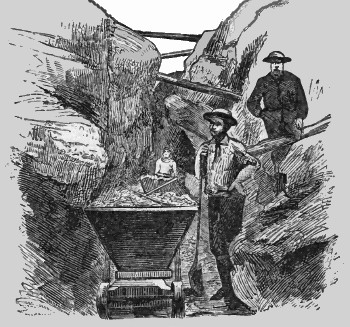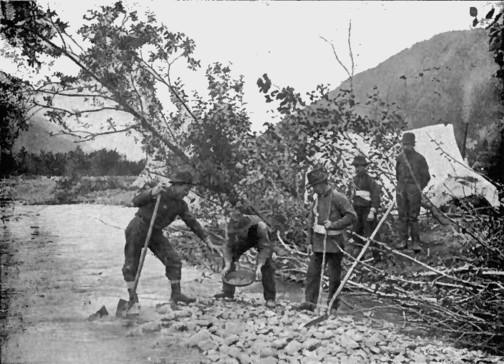Mr. Harry Lee, State Mine Commissioner, for Colorado, has written the following: "In the number of producers proportioned to the amount of development done, Cripple Creek district excels any camp before discovered in the state and possibly in the world. It does not follow that all prospects will develop into paying mines. In area the district already exceeds the expectations of the most sanguine. It will doubtless extend still farther, but it is well to bear in mind that there is a limit to the boundary. The tendency of the present time is possession of any mining stock bearing the name of Cripple Creek or that vicinity. Many good stocks exist, and may be had at -fair prices. The best interests of legitimate mining and the ultimate welfare of the district demands, that the placing of stock upon the open market, the value of which is entirely prospective, should be deprecated. The enterprise of this camp, the state press, and the various mining exchanges have kept the public well advised as to the actual conditions and values. So thoroughly and conscientiously has this been done that no legitimate investor need be deceived. To those who enter the mining arena and invest their money as a 'flyer, or a gamble, little can be said. Having determined in their own minds to gamble, warnings are of no avail. If successful, which may be among the possibilities, it will demonstrate the superior wisdom of the buyer or gambler. If unsuccessful, it will prove to his mind, at least, that mining is an unsafe business.
"In addition to the high percentage of producers in the Cripple Creek district, for the amount of exploiting done, the gold produced is exceptionally high grade, some being worth as much as $20.25 per ounce which is unusually fine. The district produces a large amount of high-grade gold ore in the form of tellurides like calaverite and sylvanite. This character of ore is much sought after and a small quantity yields large cash returns. Eventually the greatest commercial value of the district will be found in what is now termed the low-grade ores. A number of reduction plants have already been constructed and are being successfully operated.
Plans for construction now known to be under consideration will by next summer care for a tonnage of from 750 to 1,000 tons per day. Even this will prove inadequate to the demand, for with present development there is no doubt of the ability of the large mines alone to produce this amount of ore. With ample milling facilities it will be found that ore having a value as low as $8 to $10 per ton will be mined and treated at a profit. The great importance of this to the district, and the great value to the owner, to be able to develop property with this grade of ore, cannot be overestimated. Finally the frequency of ore occurrence, the strength of ore bodies, demonstrated by actual development in various places, fully establishes the permanency of the mines in this district." The thirty-five thousand people in the Cripple Creek district on January I, 1896, were distributed in a number of small towns. Cripple Creek town is the metropolis of the district. Victor, with 5,000 people, is the next largest. The remaining towns and villages are scattered around groups of mines or reduction works, and each is connected with the other by a chain of shafts and prospect holes, so that the entire place is a scene of life.
There is no spot in the district out of earshot of the blasts that thunder all day and all night on every hillside. Some of these little towns are notable. The famous bull fight was at Gillett, one of the towns four miles from Cripple Creek. Altman is the highest incorporated town in the United States, even higher than Leadville. The other towns, Mound City, Independence, Goldfield, Grassy, Anaconda, Lawrence and Elkton, have each a population of from 300 to 500 people, always supporting a school-house, a general store and a church. These are miners' towns exclusively. Civilization has not marked them for its own, as it has the larger places. Yet the little towns are filling up, perhaps, more rapidly in proportion to their size than is Cripple Creek. For the men who are looking for work, and prospectors looking for gold, and investors looking at mines, and capitalists looking over their developments, find that they must get out into the country where the actual work of the district is going on. The hills cover the wealth, and it is to them that the man in the Cripple Creek country must go. As to the hills, it was Dr. Johnson who said: "We have seen this field one field is like all other fields, let us go walk in Fleet Street." That may be said about the hills. One hill is like all the others to outward view. Yet when you come to buy a mine, the hill on which it is located determines the price it brings. Every week a new hill is coming into market. On Battle Hill are the marvelous "Independence" and the priceless "Portland" properties, the "Strong," the "Scranton," the "Anna Lee" and their neighbors. "Bull Mountain," "Grouse Hill," "Tenderfoot Hill," "Gold Hill," "Carbonate Hill," " Mineral Hill" and half a dozen others, are conjuring words among miners and investors to-day. Before the grass is green upon the hills beyond these magic mountains, other hills will have names to command respect.
The bounds have not been determined. Today's rock pile is to-morrow's treasure house. It is all strange and unnatural in the commonplace order of things. This may seem like a fairy tale. Foreign capital has done a very small proportion of the work. The man with a pick and pluck has been the most successful man in the camp. Mr. Stratton, the most successful operator, was a job carpenter in Colorado Springs when the camp opened. The man who located the " Pharmacist" was a drug clerk before he came to Cripple Creek. Four years ago thirty-five men came up to Cripple Creek in a party. Today, thirty of them are worth $10,000, sixteen of them can clean up 100,000, and four of them are worth $1,000,000. Is it a wonder that even the newsboys speculate in mining stock? Is it a wonder that the Colorado exchanges are crowded day and night, and that the constant buying has "Forced stocks up, up, up, until there seems no limit to the fascinating game?
Cripple Creek is the poor man's camp. None of the big strikes of mineral have been made by rich men. It has been developed by the gold that has One, Mr. W. S. Stratton, is probably worth $15,000,000. There was not money enough in the party, when they landed, to buy a burro. The opportunities which these men found were extraordinary. Yet every day sees men finding and improving similar opportunities. But the gold has not all been located yet, even though every foot of land within four miles of Cripple Creek is under patent or in contest. There are hundreds of claims still unworked. There are scores of holes that may be had at a nominal figure, but every day sees the number of these purchasable claims shrinking. "Three hundred people are going into the town every day," says the Chicago Times-Herald. The man who goes there with a few hundred dollars finds three business opportunities before him mining, real estate and storekeeping. The gold rush boom makes new stores a necessity. There will be twice as many people in Cripple Creek next June as there are now. These people must be fed and housed and clothed and doctored and entertained. The business of making homes for the great influx of people puts a price on real estate, and values are going up daily. As for mining, he may buy a presumably worthless hole and "strike it," as dozens of others have done. He may go outside of the district where no one believes there is any gold just as it was believed last year that there was no gold where one of the best mines is now located and stake a claim. He may lease a partially developed hole in the neighborhood of a good mine. He may take what is known as a "bond and lease," which carries an option of purchase at an agreed price within a specified time.
A word as to the geographical location of Cripple Creek. It lies in the backyard of Pike's Peak, within a few hours' ride of Colorado Springs and Manitou and the beautiful Ute Pass summer resorts, by way of the Midland Terminal and Colorado Midland Railroads. The traveler from the East, via the Santa Fe Route, may enter a sleeper at Chicago or Kansas City and go through to Colorado Springs or Denver, getting a day's rest, and then step on a sleeper and wake up in Cripple Creek. The passenger who is in a hurry may step from one sleeper to another on the same platform at Colorado Springs and complete the trip without delay. He may take his family to any of the delightful mountain resorts near Colorado Springs, spend his days in the mines and be with his family as often as he may care to snatch a few hours from business. The Atchison, Topeka & Santa Fe Railway (Santa Fe Route), in connection with the Colorado Midland and Midland Terminal, forms the only standard gauge line into the Cripple Creek district.
Return
to The Colorado History Page:
Colorado Gold Rush History


